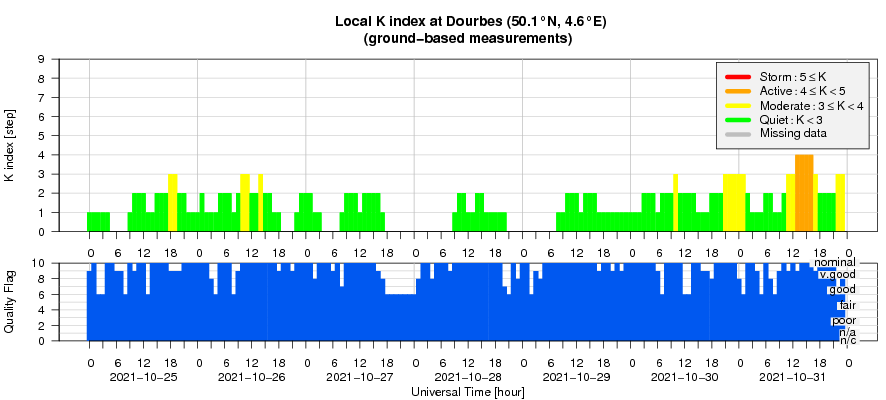- Table of Content
- 1.Space Storm im...
- 2.Topical Issue ...
- 3.Topical Issue ...
- 4.Review of sola...
- 5.PROBA2 Observa...
- 6.Noticeable Sol...
- 7.The Internatio...
- 8.Review of geom...
- 9.Geomagnetic Ob...
- 10.The SIDC Space...
- 11.Review of iono...
- 12.Action!
2. Topical Issue on "Ionospheric interactions" for JSWSC
3. Topical Issue on "Radiation impact during space missions" for JSWSC
4. Review of solar activity
5. PROBA2 Observations (25 Oct 2021 - 31 Oct 2021)
6. Noticeable Solar Events (25 Oct 2021 - 31 Oct 2021)
7. The International Sunspot Number by Silso
8. Review of geomagnetic activity
9. Geomagnetic Observations at Dourbes (25 Oct 2021 - 31 Oct 2021)
10. The SIDC Space Weather Briefing
11. Review of ionospheric activity (25 Oct 2021 - 31 Oct 2021)
12. Action!
Space Storm impacting Earth
An X1 flare was produced by sunspot region NOAA 2887 on 28 October at 15:35UT. This region has been already flare-active over the last few days, producing a flurry of C-class flares and a few low-level M-class events.
The flare was responsible for a radio black-out (High Frequency, 3-30 MHz) over mainly the Latin-American region. An HF COM advisory for civil aviation was sent: HF radio waves were possibly absorbed on the day side of the Earth.
SDO/HMI image with NOAA 2887
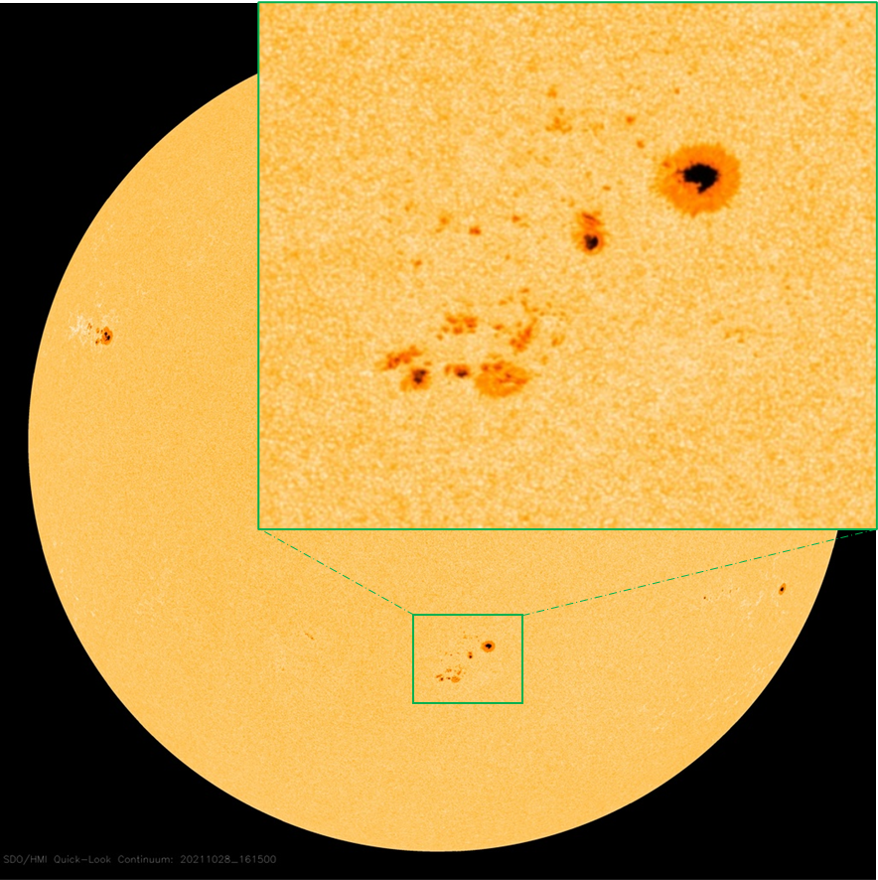
The images underneath were taken around the peak of the flare and are from SDO (2 extreme ultraviolet images on the left at temperatures of several million degrees and 80.000 degrees respectively), and on the right is an H-alpha image from the GONG network showing a view of the eruption at much lower temperatures and much lower in the Sun's atmosphere.
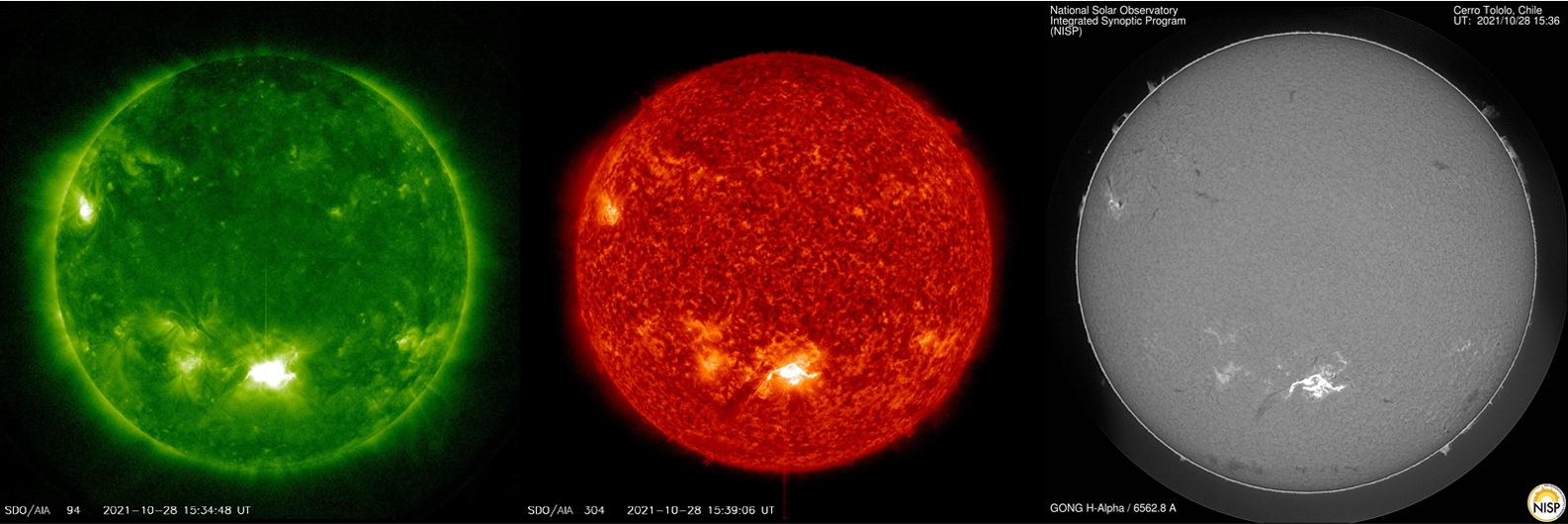
The greater than 10 MeV proton flux (GOES) had exceeded the alert threshold. Minor effects on HF radio frequencies over the polar regions were seen. This DRAP (NOAA/SWPC) imagery shows the influence from respectively the flaring event (top, Latin America affected) and from the increased proton flux (bottom, polar cap absorption) on global HF communications. The Polar Cap Absorption was not strong enough to trigger an HF COM advisory for civil aviation (> 2dB absorption for 30MHz).
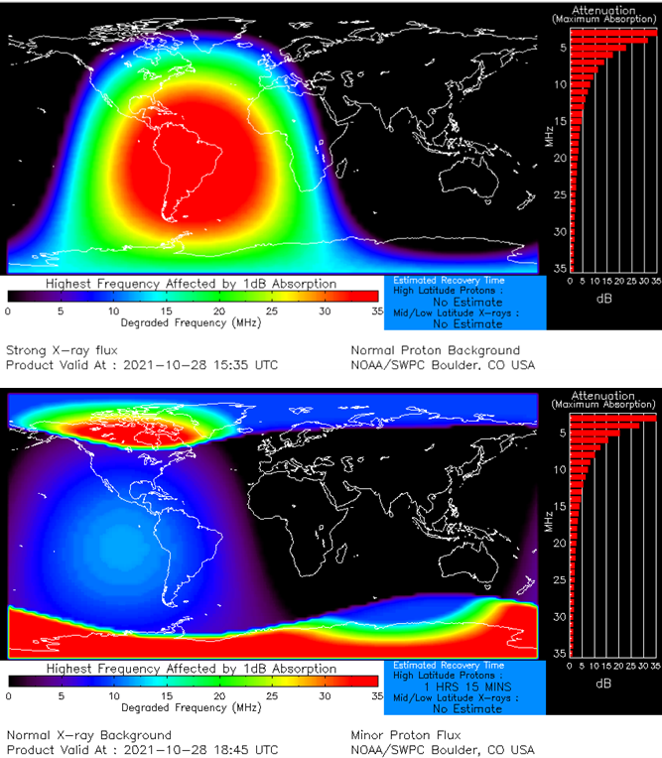
There was also an increase in the greater than 100 MeV proton flux. This evolution had lead to minor increases in some of the ground-based neutron monitors (NMDB).
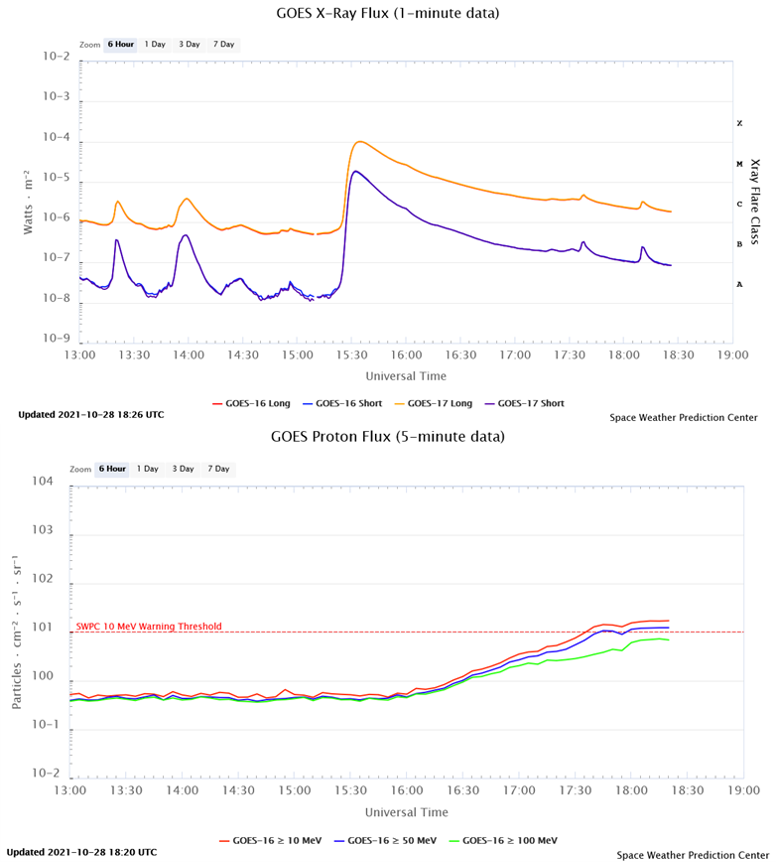
A coronal dimming (a transient darkening in the Sun's outer atmosphere), as well as a coronal wave were seen, both indicating that a plasma cloud was ejected. The SIDC's Solar Demon software tool (see the animation underneath) provided images of these features in near real time, and are based on SDO/AIA 211 imagery.
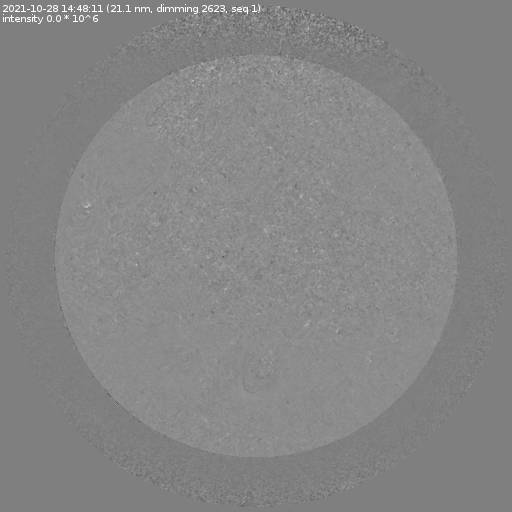
Another indication for a CME was the detection of a Type II radio-burst, indicative of a shock passing through the Sun's atmosphere. Based on data from NOAA/USAF Radio Solar telescope Network, we could conclude that the shock seemed to move pretty fast, with a speed near 1450 km/s. Observations by the radio telescopes in Humain, Belgium confirmed also that this particular eruption produced only for a few minutes radio noise on GNSS frequencies, but was much more prominent on the frequencies between 200 and 650 MHz, This can be seen in the much intenser patches in the radio spectrogram underneath (time on the horizontal axis, frequencies on the vertical). Note the top portion in this graph shows the GOES x-ray flux.
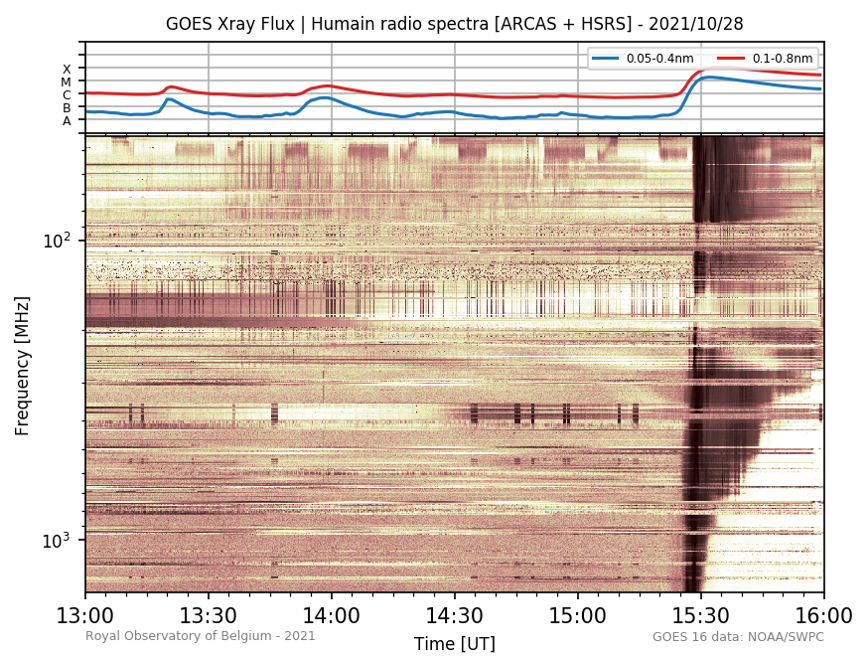
A CME is also seen in coronagraphic images from STEREO-A. The CME seemed to have a true speed in excess of 1000 km/s. Most of the CME was directed south of the Sun-Earth line, but there's a clear earth-directed component too. Note there's another CME in the same line-of-sight, but this is from another, earlier event and not associated with the X-class eruption.
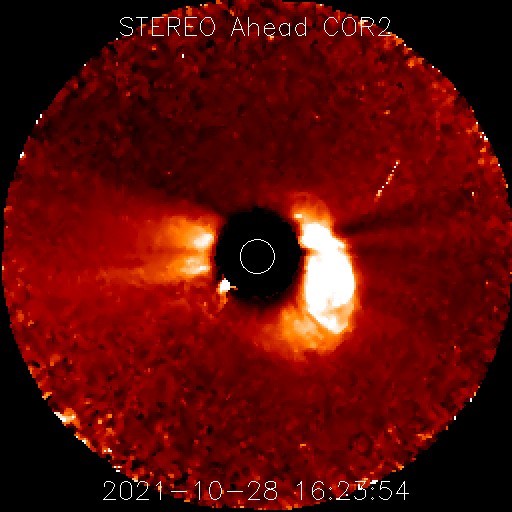
Below, 2 more movies: one from the SWAP instrument on board the PROBA2 satellite, showing the eruption in extreme ultraviolet at temperatures near 1 million degrees. The second clip is from the SOHO/LASCO C3 instrument, showing the fast and asymmetrc CME.
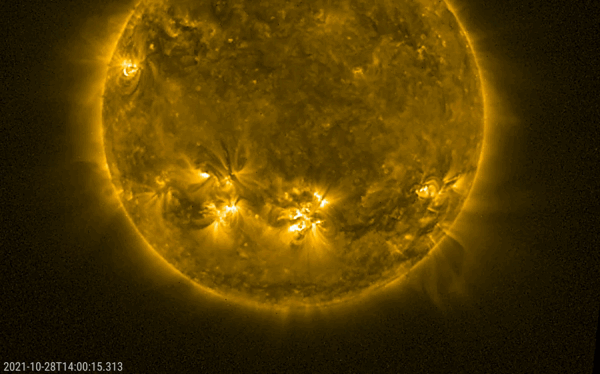

Arrival of a Plasma Cloud near Earth
A shock in the solar wind was observed on 31 October at 09:14UT (DSCOVR). The resulting geomagnetic disturbance was mild, with NOAA/SWPC's Estimated Kp of max 5 (minor geomagnetic storm), and only active conditions recorded at Dourbes. The CME impact and associated geomagnetic disturbance are significantly weaker than expected, most likely because the CME was even further deflected southward than initially observed, hence the Earth encountered only the very outer flank of this interplanetary CME.
Topical Issue on "Ionospheric interactions" for JSWSC
The Journal of Space Weather and Space Climate (JSWSC - https://www.swsc-journal.org/) opens a Topical Issue "Tackling ionospheric interactions and their impact on radio systems at the dawn of Solar Cycle 25" to appear in 2022.
This Topical Issue arises from the European Space Weather Week 2021, primarily from the Session sw04 entitled “Ionospheric Interactions”. However, it is not reserved to papers presented during this session and is open for all submissions within the scope of this TI.
The most challenging features of the ionosphere behavior are the ionospheric irregularities, as they result from dynamical processes, such as plasma instabilities and turbulence, and vary on a large range of temporal and spatial scales. Modeling and forecasting the ionospheric irregular behavior and its impact on radio systems is still an open challenge to the scientific community in the context of predicting and mitigating harsh effects on radio systems, e.g. GNSS and HF/VHF/UHF radio communications. Currently, different instruments support space weather studies of the ionosphere: from ground-based observations (TEC and scintillation receivers, coherent and incoherent scatter radars, magnetometers, all-sky-imagers, radio telescopes) to in-situ measurements provided by LEO satellites and sounding rockets.
This special issue aims at pin-pointing the state-of-art on the monitoring, modeling and forecasting of the dynamical status of the ionosphere and its impact on radio systems, with focus on the preparedness for Solar Cycle 25. Contributed papers may address (but are not limited to) recent developments in modelling and forecasting, monitoring methodologies, data analysis (especially based on multi-instrument observations), measurement campaigns and international initiatives related to the understanding of ionospheric structures, morphology, dynamics and related threats on systems, at all latitudinal sectors.
Manuscripts must be submitted via the JSWSC online submission tool. Guidelines for submission of papers are found on the JSWSC web site under the tab "Instruction for Authors". https://www.swsc-journal.org/author-information/instructions-for-authors
Deadline (sending title and list of authors of intended papers to the Topical Editor-in-Chief (TEiC): Luca Spogli (luca.spogli@ingv.it): 15 November 2021.
Deadline (submitting papers via the JSWSC online submission tool): 31 July 2022.
All manuscripts will be peer reviewed according to the quality standards of international scientific journals. The type of contributions must fit the style of JSWSC. All manuscripts should contain enough new insight, present the results against a properly referenced background of existing work, and present adequate evidence that supports the conclusions. Accepted papers are published in electronic format only, and are freely available to everyone via the JSWSC website. JSWSC offers the possibility to include electronic material, such as animations, movies, codes and data. Being an electronic-only journal we start processing TI submissions as soon as they arrive and publish them as soon as the review process is complete.
Topical Editor-in-Chief (T-EiC):
Luca Spogli (luca.spogli@ingv.it), Istituto Nazionale di Geofisica e Vulcanologia, Roma, Italia
Topical Editors (TE):
Kshitija Deshpande (deshpank@erau.edu), Embry-Riddle Aeronautical University, USA
Wojciech Miloch (w.j.miloch@fys.uio.no), University of Oslo, Norway
Guozhu Li (gzlee@mail.iggcas.ac.cn), Institute of Geology and Geophysics, Chinese Academy of Sciences, China
Sean Eldvige (s.elvidge@bham.ac.uk), University of Birmingham, UK
For questions regarding this Topical Issue, please, contact the T-EiC. For questions concerning the submission process the Editorial Office (jswsc@edpsciences.org) should be contacted.
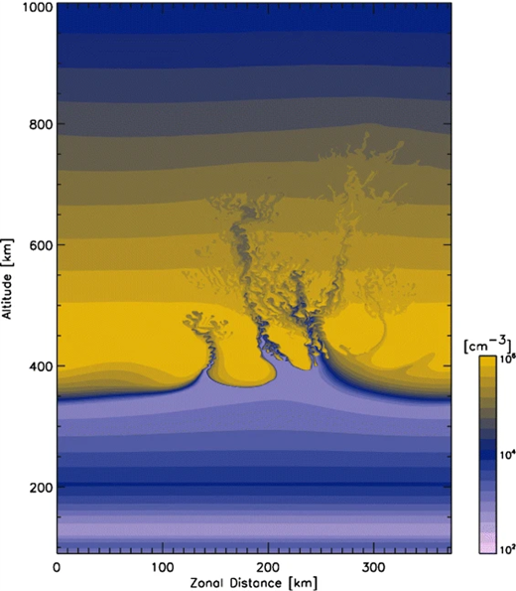
Credits: Yokoyama, 2017
https://progearthplanetsci.springeropen.com/articles/10.1186/s40645-017-0153-6
Topical Issue on "Radiation impact during space missions" for JSWSC
The Journal of Space Weather and Space Climate (JSWSC - https://www.swsc-journal.org/) opens a Topical Issue "Advances in space weather forecasting and in the assessment of radiation impact during space missions" to appear in 2022.
This Topical Issue (TI) arises from the European Space Weather Week 2021 (ESWW17) held in October 2021, primarily from the Session cd01 entitled “Advances in space weather forecasting and in the assessment of cosmical radiation impact on astronauts during space missions”. However, it is not reserved for papers presented during this session and is open for all submissions within the scope.
In connection with the planned rising number of short- and long-term space missions planned in the near future, reliable assessment of space radiation and the associated forecast of space weather conditions have become not only real challenging but also crucial tasks. This TI is devoted to taking stock of the recent advances made in the assessment of forecasting space weather in relation to human missions to Mars, for orbital and planned lunar stations. Such analysis plays a key role in our understanding of radiation risks for astronauts and for developing effective shielding and radioprotectors. In the remit of this TI, papers are of particular interest with recent advances in the current physical understanding, addressing state of art about the processes that occur at the Sun (as well as near the Earth and planets) and yielding critical ingredients to develop reliable forecast methods. Besides discussing the progress made recently in this area, we would particularly welcome contributions about long-term forecasting, including e.g. studies of very rare extreme events. Further, addressing our capabilities of the relevant remote sensing would also be welcome.
Manuscripts must be submitted via the JSWSC online submission tool. Guidelines for submission of papers are found on the JSWSC web site under the tab "Instruction for Authors" https://www.swsc-journal.org/author-information/instructions-for-authors
Deadline (sending title and list of authors of paper to Topical Editor-in-Chief (TEiC): Elena Popova (elena.popova@ubo.cl)): 15 November 2021.
Deadline (sending papers via the JSWSC online submission tool): 30 June 2022.
All manuscripts will be peer reviewed according to the quality standards of international scientific journals. The type of contributions must fit the style of JSWSC. All manuscripts should contain enough new insight, present the results against a properly referenced background of existing work, and present adequate evidence that supports the conclusions. Accepted papers are published in electronic format only, and are freely available to everyone via the JSWSC website. JSWSC offers the possibility to include electronic material, such as animations, movies, codes and data. Being an electronic-only journal we start processing TI submissions as soon as they arrive and publish them as soon as the review process is complete.
Topical Editor-in-Chief (T-EiC):
Elena Popova (elena.popova@ubo.cl) Bernardo O'Higgins University, Santiago, Chile, Skolkovo Institute of Science and Technology, Moscow, Russia
Topical Editors (TE):
Robertus Erdelyi (robertus@sheffield.ac.uk), University of Sheffield, Sheffield, UK
Marianna Korsos (mak102@aber.ac.uk), Aberystwyth University, Aberystwyth, UK
Jingnan Guo (jnguo@ustc.edu.cn), University of Science and Technology of China (USTC), Hefei, Anhui, China
Francesca Zuccarello (francesca.zuccarello@dfa.unict.it), University of Catania, Italy
For questions regarding this Topical Issue, please, contact the T-EiC. For questions concerning the submission process the Editorial Office (jswsc@edpsciences.org) should be contacted.
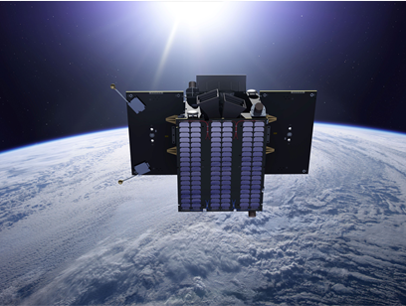
Credits: PROBA2
https://proba2.sidc.be/node/290
Review of solar activity
The solar flare activity reached a high level. NOAA Active Region (AR) 2887 released an X1 flare on 28 Oct, peaking at 15:48 UT. The same AR also produced two M-flares on the same day as the X-flare (an M1 flare at 07:39 UT and an M2 flare at 10:37 UT). NOAA AR 2891 released a third M flare (M1) on 29 Oct, 02:53 UT. Numerous C-class flares were detected, with the majority released by these two ARs.
A halo Coronal Cass Ejection (CME) was detected in SOHO/LASCO-C2 images by the software CACTUS. It occurred around the same time and place on the solar disk as the X1 flare by AR 2887 on 28 Oct. AR 2887 was at that time located close to the solar central meridian in the southern hemisphere. The CME was classified as potentially geo-effective.
The greater than 10 MeV proton flux increased above nominal levels due to a proton event associated with the X1 flare of 28 Oct 15:48 UT. It exceeded the threshold of 10 particles cm-2 s-1 sr-1 on 28 Oct 17:35 UT and peaked at 30 particles cm-2 s-1 sr-1 on 29 Oct 02:50 UT. It dropped below the 10 particles cm-2 s-1 sr-1 level on 30 Oct 16:00 UT and remained below that level for the rest of the week.
The greater than 2 MeV electron flux was below the 1000 pfu and at nominal levels over the past week. The greater than 2 MeV electron fluence was at nominal levels.
PROBA2 Observations (25 Oct 2021 - 31 Oct 2021)
Solar Activity
Solar flare activity was very low during the week.
In order to view the activity of this week in more detail, we suggest to go to the following website from which all the daily (normal and difference) movies can be accessed: https://proba2.oma.be/ssa
This page also lists the recorded flaring events.
A weekly overview movie can be found here (SWAP week 605). http://proba2.oma.be/swap/data/mpg/movies/weekly_movies/weekly_movie_2021_10_25.mp4
Details about some of this week's events can be found further below.
If any of the linked movies are unavailable they can be found in the P2SC movie repository here https://proba2.oma.be/swap/data/mpg/movies/
Friday
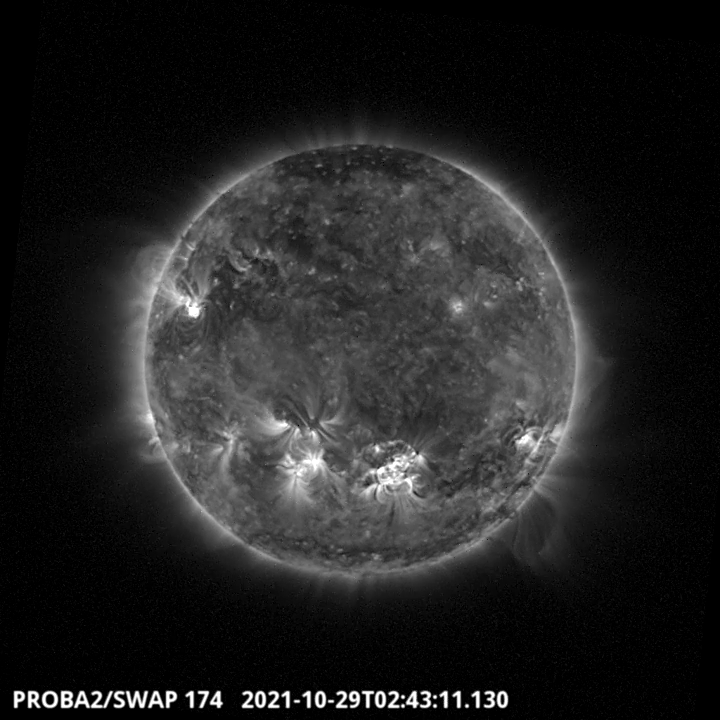
A M1.5 is one of the several M flares of the week. It originated from the NOAA active region labelled 2891. It is visible on the North East quadrant of the solar disk on the SWAP image above around 2:43 UT. Find a movie of the events here (SWAP movie) https://proba2.oma.be/swap/data/mpg/movies/20211029_swap_movie.mp4
Noticeable Solar Events (25 Oct 2021 - 31 Oct 2021)
| DAY | BEGIN | MAX | END | LOC | XRAY | OP | 10CM | TYPE | Cat | NOAA |
| 26 | 0240 | 0247 | 0254 | M1.3 | ||||||
| 26 | 1542 | 1557 | 1602 | M1.0 | 2891 | |||||
| 28 | 0730 | 0740 | 0745 | S30W3 | M1.4 | 1N | 2887 | |||
| 28 | 1019 | 1028 | 1037 | S30W2 | M2.2 | 1F | 2887 | |||
| 28 | 1517 | 1535 | 1548 | S26W5 | X1.0 | 2N | III/3II/3IV/2 | 2887 | ||
| 29 | 0222 | 0242 | 0253 | N16E54 | M1.5 | 1N | 2891 |
| LOC: approximate heliographic location | TYPE: radio burst type |
| XRAY: X-ray flare class | Cat: Catania sunspot group number |
| OP: optical flare class | NOAA: NOAA active region number |
| 10CM: peak 10 cm radio flux |
The International Sunspot Number by Silso
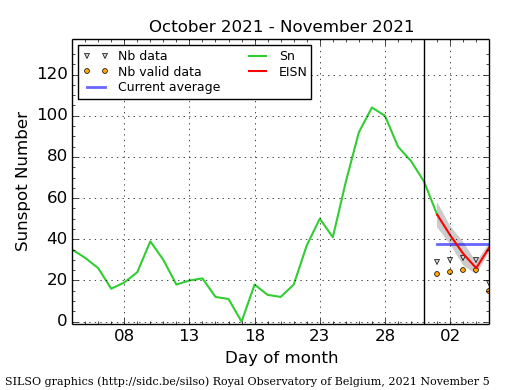
The daily Estimated International Sunspot Number (EISN, red curve with shaded error) derived by a simplified method from real-time data from the worldwide SILSO network. It extends the official Sunspot Number from the full processing of the preceding month (green line), a few days more than one solar rotation. The horizontal blue line shows the current monthly average. The yellow dots gives the number of stations that provided valid data. Valid data are used to calculate the EISN. The triangle gives the number of stations providing data. When a triangle and a yellow dot coincide, it means that all the data is used to calculate the EISN of that day.
Review of geomagnetic activity
The solar wind was slow (between 300 and 400 km/s) until a weak Fast Forward (FF) shock passed the L1 point on 31 Oct 09:14 UT. This FF shock with a speed increase to 460 km/s, was part of an Interplanetary Coronal Mass Ejection (ICME) that was associated with the X1 flare of 28 Oct 15:48 UT. Its total magnetic field (Btot) varied between 1 and 13 nT, while its Bz component fluctuated between -11 and 8 nT.
The interplanetary magnetic field (IMF) was directed towards the Sun, this is the negative sector. On Oct 30, Earth was situated in the positive sector with the IMF directed away from the Sun.
The geomagnetic activity was quiet (NOAA Kp and K Dourbes up to 2) but reached the minor storm level (NOAA Kp 5) when the ICME passed Earth on 31 Oct. Conditions returned to quiet by 1 Nov.
The SIDC Space Weather Briefing
The Space Weather Briefing presented by the forecaster on duty from Oct 24 to 31. It reflects in images and graphs what is written in the Solar and Geomagnetic Activity report.

A pdf-version: https://www.stce.be/briefings/20211101_SWbriefing.pdf
The movie: https://www.stce.be/briefings/20211101_SWbriefing.m4v
Review of ionospheric activity (25 Oct 2021 - 31 Oct 2021)
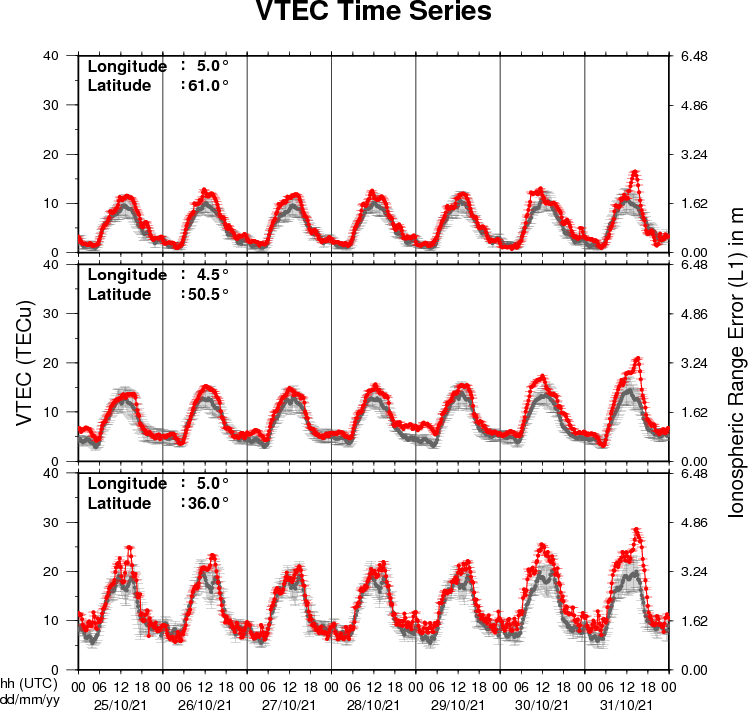
The figure shows the time evolution of the Vertical Total Electron Content (VTEC) (in red) during the last week at three locations:
a) in the northern part of Europe(N61°, 5°E)
b) above Brussels(N50.5°, 4.5°E)
c) in the southern part of Europe(N36°, 5°E)
This figure also shows (in grey) the normal ionospheric behaviour expected based on the median VTEC from the 15 previous days.
The VTEC is expressed in TECu (with TECu=10^16 electrons per square meter) and is directly related to the signal propagation delay due to the ionosphere (in figure: delay on GPS L1 frequency).
The Sun's radiation ionizes the Earth's upper atmosphere, the ionosphere, located from about 60km to 1000km above the Earth's surface.The ionization process in the ionosphere produces ions and free electrons. These electrons perturb the propagation of the GNSS (Global Navigation Satellite System) signals by inducing a so-called ionospheric delay.
See http://stce.be/newsletter/GNSS_final.pdf for some more explanations ; for detailed information, see http://gnss.be/ionosphere_tutorial.php
Action!
Check out our activity calendar: activities and encounters with the Sun-Space-Earth system and Space Weather as main theme. We provide occasions to get submerged in our world through educational, informative and instructive activities.
If you want your event in our calendar, contact us: stce_coordination at stce.be
in 2021
* November 18, ISSI Game Changers Online Seminars: Human Spaceflight - Earth Radiative Budget and Energy Imbalance Observed from Space
* November 22 - 26, Online SWx introductory Course (SWIC), organisation by the STCE - complete
* November 28, Dag van de wetenschap, Brussels, Belgium - STCE will bring 'Panic in the Space Weather Room' (Dutch)
* December 2, ISSI Game Changers Online Seminars: Tipping positive change to avoid climate tipping points
* December 3-4, Space Days at the Big Bang festival, STCE will bring 'Panic in the Space Weather Room' and 'Satellites'
* December 9, ISSI Game Changers Online Seminars: Space Weather
* December 16, ISSI Game Changers Online Seminars: Sursurface Life on Earth and on Other Planets in the Solar System
In 2022
* Januari 25, Public Lecture on the Solar Corona in EUV (Dutch), Urania, Hove, Belgium
* February 14-18, online Space Weather Introductory Course by SWEC, Space Weather Education Center - registrations are open
* February 22, Public Lecture on Space Weather and Aviation (Dutch), Urania, Hove, Belgium
* February 26, Public Lecture on Space Weather, Satellites and Aviation (Dutch), UGent Volkssterrenwacht Armand Sien, Gent, Belgium
* March 14-16, onsite (!) Space Weather Introductory Course by SWEC, Space Weather Education Center - registrations are open
* April 28, Public Lecture on SDO/EUI, Astropolis, Oostende, Belgium
* August 25, Public Lecture on Space Weather and Aviation, Astropolis, Oostende, Belgium
* October 24-28, 18th European Space Weather Week, Zagreb, Croatia
Check: https://www.stce.be/calendar

